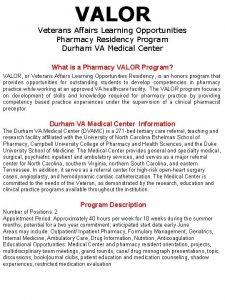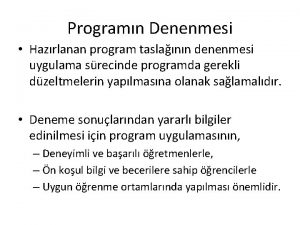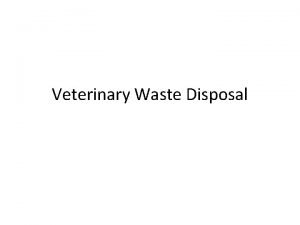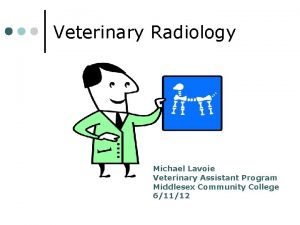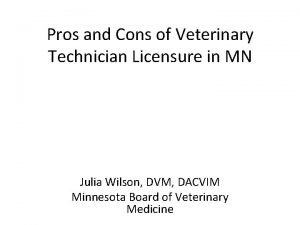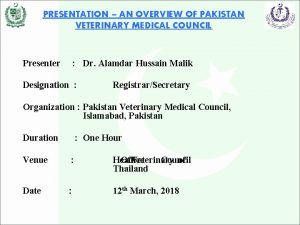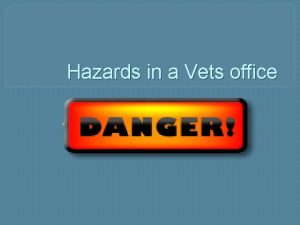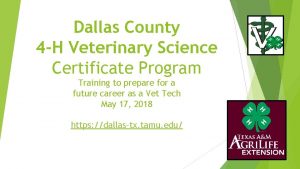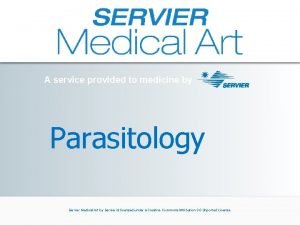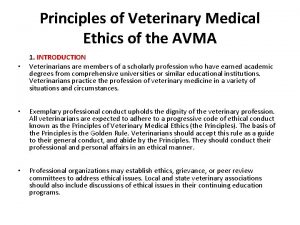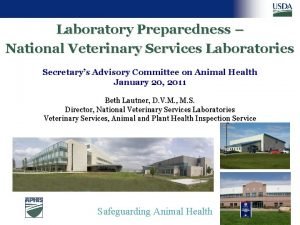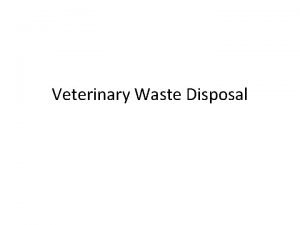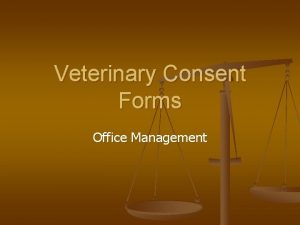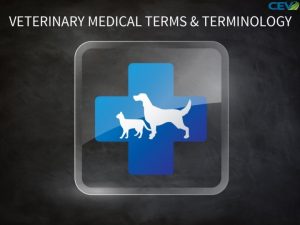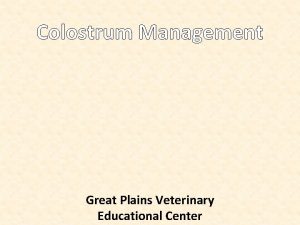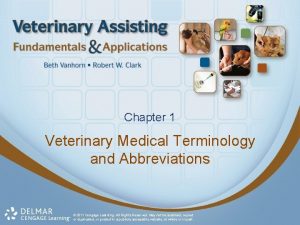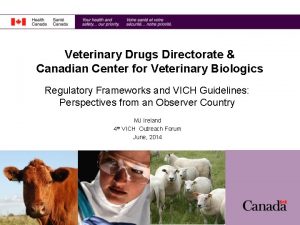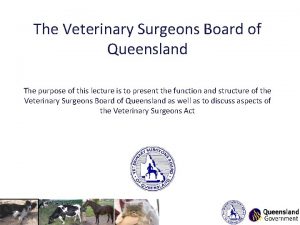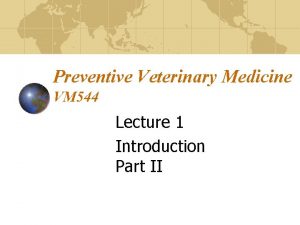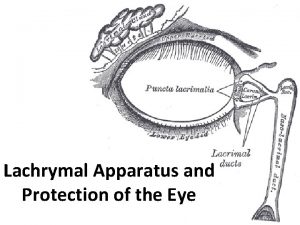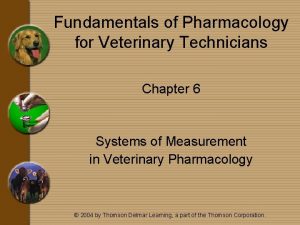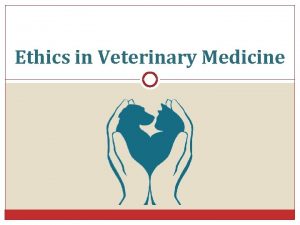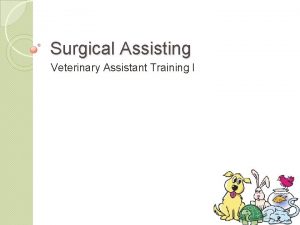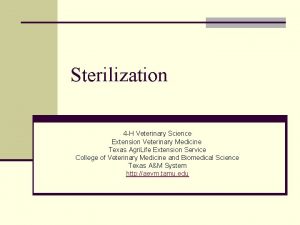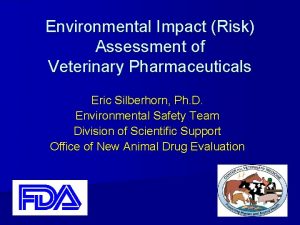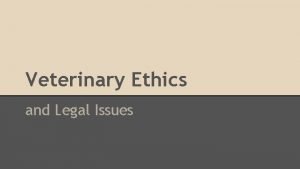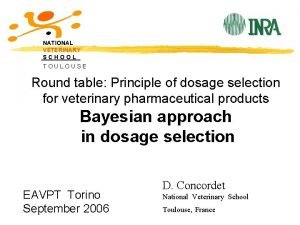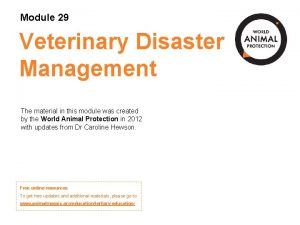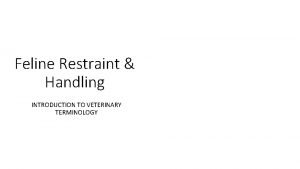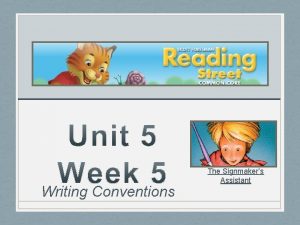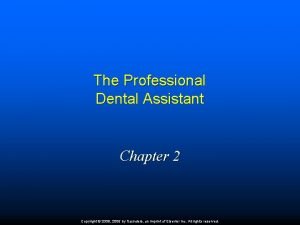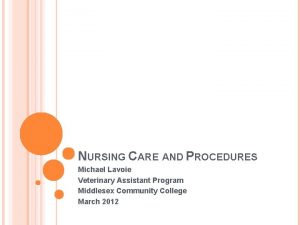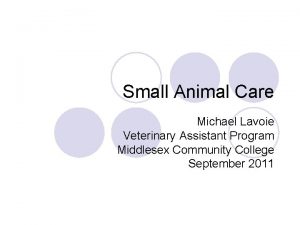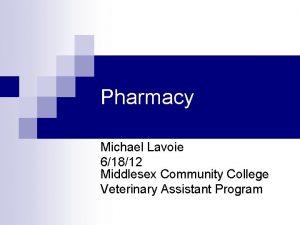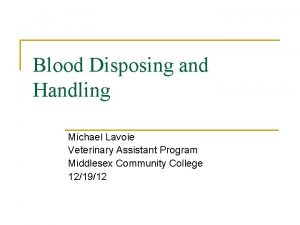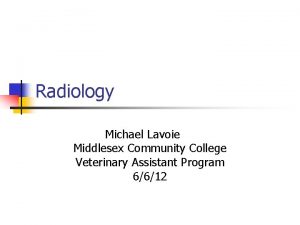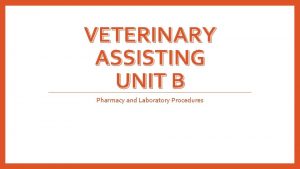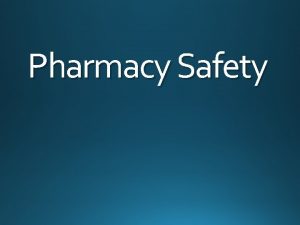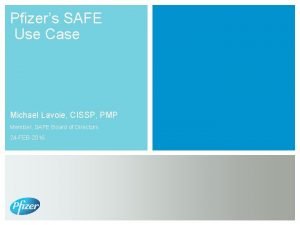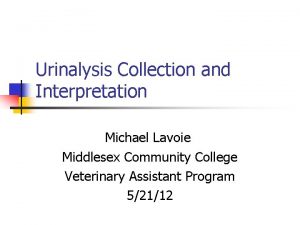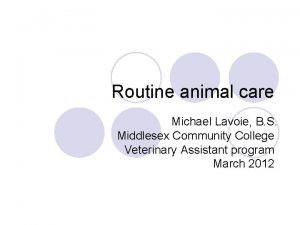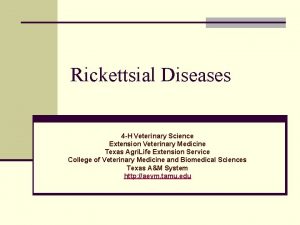Pharmacy Procedures Michael Lavoie 61312 Veterinary Assistant Program












































































- Slides: 76

Pharmacy Procedures Michael Lavoie 6/13/12 Veterinary Assistant Program Middlesex Community College

Reading a Prescription n Often abbreviated Rx The prescription is the type of medication, amount of medication, and directions of use for the medication Prescription is determined by the veterinarian, and we are there to put the prescription together.

Several parts to a prescription n n Medication name Medication strength Method of administration Amount to be administered Frequency of the medication Length of use Amount to be dispensed Special instructions Number of refills Veterinarian name

Labeling a Prescription n n Purpose is to indicate to the owner how to properly give the medication and identify the medication in the container When a label is prepared it should be legible if handwritten, clean and understandable

n The following information should be on a label: n n Veterinary facility name, address and phone number Name of the prescribing veterinarian Client name Client address, if it is a controlled substance

n n n n Patient name or ID number Medication name Medication strength Quantity dispensed Expiration date of the medication Number of refills Amount per treatment or use Route of use

n n Frequency of treatments Length or duration of use Special instructions Additional labeling can used, such as warning labels in sticker form.

Some stickers you may use n n n “keep refrigerated” “give with food” “for the eye” “for the ear” “shake well before using” “give by mouth only”

Labeling n n Each container should be labeled for veterinary use only When labeling directions for medication use regular wording for the clients Medical abbreviations should be avoided Recheck the label for accuracy, and go over with the client, so they understand the directions as well

Dispensing medications n n Every medication needs to have a childproof container Only exception is for clients who ask for one that isn’t due to medical reasons making it difficult to open the lid

Dispensing medications n n It is important to explain that there is always the possibility of children or pets getting into a non child proof container Be sure to mark in the medical record that the owner requested a non child proof cap

Medication Containers n n Plastic vials and bottles are commonly used with a twist off or snap off lid Size of the container is measured in drams Proper sized vial should be used to hold the amount of medication dispensed Vials are usually amber colored

Medication containers n n n The reason is to keep the medication for degrading in sunlight Vials are used for pills and capsules Bottles are used for liquid medications

Drug Identification n Proper dosage and strength are selected by veterinarians. We need to make sure that the drug we are dispensing is correct A patients condition may worsen or not improve if the wrong drug, or concentration is given

Drug Identification n n Many drugs have similar names Compare the spelling of the drug with the drug on the drug label Also drugs come in different concentrations so always make sure you have the right concentration Drug strengths can be written in milligrams (mg), millimeters (ml), cubic centimeters (cc), or grains (gr).

Drug Identification n Never dispense a drug that is expired. Can find the expiration date on the bottle or lid of the drug bottle Check these for accuracy: n n n Right Right patient drug strength quanitity frequency

Amount to be Dispensed n n n May be listed on the prescription or may need to be calculated by the veterinary assistant Requires a knowledge of pharmacy abbreviations and basic math Lets work on an example

Amoxicillin 250 mg PO BID X 14 n n n Determine how often the drug is given Determine how long the drug is to be given Multiply the number of doses per day by the duration of treatment

n n n Locate the strength of the drug as closely as possible to the prescription Determine how many units per dose are needed Multiply the number of tablets per dose by number of doses

Pill counting tray n Is a device that has a flat area for medicine to be placed and a channel or funnel like area to place medication that has been counted

Types of medication n Divided into three categories n n n Over the counter medications: can be purchased by any one at a human pharmacy Prescription drugs: ordered or scripted by veterinarians Controlled substances: prescription drugs that can have the potential for addiction or abuse

Types of medications n n n Controlled drugs are regulated by the DEA Have specific regulations and guidelines for ordering, storing, and dispensing Veterinarian must have a controlled substance license

Controlled Substances n n Only person who can order and prescribe controlled drugs are licensed veterinarians Licenses are issued by the DEA and renewed every three years Must legally be stored behind 2 locks Access to the controlled substances are limited to one or two people on shift

Controlled Substances n n Must be logged in the controlled substance log Written entries are required for every substance dispensed by the facility Must be recorded in blue or black ink and records need to be kept for 2 years Varies from state to state

Information for Controlled Substances n n n Name of controlled substance Drug strength Drug form (tablet, capsule, liquid, injection, etc. ) Quantity dispensed Quantity on hand Date dispensed Time dispensed Client name and address Patient name Animal breed/species Initials of person dispensing

Educating Clients on Medication Use n n The veterinary assistant should be able to review all medication instructions before the client and patient leave the facility Should be urged to call with any questions

n n Some clients will receive a handout about how to give the medication with examples or diagrams on how to give It is important for the veterinary assistant to be able to review or show the client how to give the medication n n Why the medication is administered How the medication is to be administered How much is to be administered When the medication is to be administered

Administering Oral Medications n n Administered by mouth Can be tablets, capsules, or liquids Small animals like dogs and cats require the mouth to be opened and medication to be placed in the back of the mouth Larger animals like live stock may require more power to hold and give medications to

Instrument use n n n Some animals may require pet pillers or other medication aids A pet piller is a small device, usually made of plastic, that has a long thin handle with a plunger on the end The plunger holds the medication and the handle is used to throw the medication to the back of the mouth

n n Large animals may require a balling gun which is a metal device that has a long handle and a plunger at the base Disposition of the animal also plays a part in how the medications are delivered. When administering medication it is important to consider the drug used Tablets and capsules can be given in peanut butter or a bit of cheese

n n Also, a product called pill pockets can be used in dogs and cats that have various flavors that appeal to the animal. Tablets and capsules can be crushed into a powder and administered in water using an oral dosing syringe A mortar and pestle can be used to grind down the medication into a fine powder Pastes can also be made to administer medication (usually done at a compounding pharmacy

Administering Oral Medications in Dogs 1. 2. 3. 4. Apply gloves Elevate head upward Open mouth at side by pressing between the upper and lower jaw joint by cheek Place medicine between index finger and thumb of free hand

Administering Oral Medications in Dogs 5. 6. 7. place middle finger of same hand at front of mouth and apply pressure to open mouth wide Drop the tablet or capsule at the back of the throat If safely able to use index finger of free hand, push the medication deeply into the throat

Administering Oral Medications in Dogs 8. 9. 10. Close the mouth and hold until patient swallows Gently blow on face or rub throat to stimulate swallowing Monitor for any signs of the medication not being ingested

Administering oral medications in cats 1. 2. 3. 4. Apply gloves Have someone hold front feet and body while pilling Elevate the head upward Open mouth by pressing at the side between the upper jaw and lower jaw joint by cheek

Administering Oral Medication in Cats 5. 6. 7. Place medicine between index finger and thumb of free hand Place middle finger of the same hand at front of mouth and apply pressure to open mouth wide Drop the tablet or capsule at the back of the throat

Administering Oral Medication to a Cat 8. 9. 10. 11. If safely able to use index finger of free hand, push the medicine deeply into the throat Close the mouth and hold until the patient swallows Gently blow on face or rub throat to stimulate swallowing Monitor for any signs of the medication not being ingested

Using a Pet Piller or Balling Gun 1. 2. 3. 4. Apply gloves Place pill in the end of the plunger of the pet piller or balling gun Apply the end of the piller or balling gun into the side of the mouth between the upper and lower teeth Once in the mouth, push plunger to release medicine to back of the throat

Using a Pet Piller or Balling Gun 5. 6. 7. 8. Remove the balling gun or pet piller and immediately elevate head upward Blow on nose or rub neck to stimulate swallowing Check to make sure the medicine was swallowed Disinfect items and put away

Administering liquids and pastes 1. 2. 3. 4. Apply gloves Elevate head upwards Insert syringe or paste tube in side of the mouth between the upper and lower teeth Press the plunger to the desired amount into the back of the throat

Administering liquids and pastes 5. 6. 7. 8. Remove syringe or tube and continuing elevating the head upwards Blow on nose or rub throat to stimulate swallowing Keep mouth held shut until swallowing occurs Disinfect any tools and put away






Administering Aural Medications n n n Are placed in the ear and may be used for ear infections, ear cleaners or ear mites The opening of the ear canal includes the tragus Area located caudally and with no har is the pinna

Aural Medications n n Internal ear canal is L-shaped Ear canal is made of cartilage Treated for many reasons, most common is ear infections Long eared dogs have ears that do not allow for good ventilation and moisture and bacteria may easily build up in the canal

n n Some dog breeds such as poodles and bichons have hair that grows in the canal which may prevent proper ventilation from occurring All animals are susceptible to ear mites Flies and mosquitoes may bite the ear flaps such as in large animals which can cause crusting and bleeding on the ear edges Wax and other debris can be lodged in the are causing trauma and irritation

Hematomas n n Hematomas can be made by damage to the ear or excessive head shaking When an animal shakes its head severely it may cause blood vessel to rupture and the pinna to fill with blood

Aural Medications n n n Are usually in liquid form Can be either a drop or ointment Some medications can be packaged in bottles or tubes Many tubes are meant for multiple uses Often ears need to be cleaned before applying medications

Aural Medications n n n The veterinary assistant can be asked to show the clients how to properly apply ear medications at home Gloves should be worn to prevent contamination Also tops to ear medications should be cleaned between ears to prevent contamination

Administering Aural Medications 1. 2. 3. Apply gloves Clean ears as recommended by the veterinarian Place medication into dropper or tip deep inside the ear canal only to the depth of the start of the vertical portion of the L-shape

Administering Aural Medications 4. 5. Apply the proper amount of medication into the ear as noted by the veterinarian. This is usually in drops that are counted according to the veterinarian’s label Remove the medication dispenser from the ear

Administering Aural Medications 6. 7. 8. Massage the base of the outside of the ear canal. This will create a swishing sound caused by the medication moving around the ear canal Wipe any solution that may have leaked onto the outside of the ear flap of hair Disinfect the medication dispenser with alcohol and place in appropriate area





Administering Topical Medications n n Topical medication is a substance applied to the outside of the skin coat on an external body surface Topical medications may include antiseptics, flea and tick medications, or wound treatments

Topical medications n n n Areas of wounds or abrasions should be soaked prior to applying the medication Can be done by soaking with warm water or surgical scrub Some topical medications can come in a single use container or in a large volume meant for multiple uses

Topical medications n n Flea and tick medications should be applied according to label medications Each product treats specific animals for specific reasons Some topicals treat fleas only, others ticks Gloves should be worn when applying these medications because of the various chemicals in them

Administering Topical Medications 1. 2. 3. 4. Apply gloves Clean area as necessary Use a tongue depressor to transfer an amount of topical medication if the container is for multiple uses Apply to ointment onto the area in a circular motion, starting at the center of the wound and gently working outward

Administering Topical Medication 5. 6. 7. Do not contaminate the medication by touching items that have touched the animal. Flea and tick medications should be applied as directed on the instructions Separate hair from skin and apply as directed Clean area and put items away

Ophthalmic medications n n n Are ointments or solutions that are applied to the eyes May be used to treatment of an eye condition or used prior to bathing or grooming to protect the cornea from damage Avoid the contact of the applicator with the eye

Ophthalmic ointment n n n Touching the tip to the eye will not only contaminate the medication but may also cause trauma to the eye Wear gloves when applying eye medication Eye will need to be held open for a better view

Ophthalmic medications n n Eye drops can be dropped into the eye by holding the bottle over the open eye Ointments can be applied by a thin layer over the lower eyelid and allow the animal to blink several times to move the substance throughout the eye

Administering Ophthalmic Medication 1. 2. 3. 4. Apply gloves Wipe any discharge from the patient’s eye using a gauze sponge Open the end of the ophthalmic medicine and hold in one hand Using the free hand, use the index finger and thumb to pull the upper and lower lids apart to see the eye

Administering Ophthalmic Medication 5. 6. 7. 8. The thumb pulls the lower lid down, the index finger pulls the upper lid upwards The other finger may rest on the head of the animal Gently tilt the head upwards Apply the drops or ointment gently into the eye, counting each drop and applying the proper amount. Do not touch the surface of the eye with the dispenser

Administering Ophthalmic Medications 9. 10. 11. 12. Apply the ointment over a thin layer on the lower lid. Do not touch the surface of the eye with the dispenser Release the eyelids Allow the animal to blink to move the medication through the eye Clean the dispenser with a small amount of alcohol on a gauze sponge

Medication Storage n n Medications have an expiration date and should be monitored for proper dating prior to dispensing Medications in the pharmacy should be stored with the oldest dates being used first to use up the products that will expire the fastest

Medication Storage n n Expiration date is located on the bottle Must be included on the pharmacy label when dispensing medication All outdated medication should be removed from the shelves Drugs typically arrive with an insert within the container that details the actions and use of the drug

Medication Storage n n n Storage information is also located on the insert Some items are stored at room temperature, other may need refrigeration Biologicals, like vaccines, are stored under refrigeration

Medication Storage n n n Some drugs need to be stored in a dark place and kept away from direct light These drugs lose their efficacy when exposed to light. All drugs without information on storage should be kept at room temperature in a clean dry area.

Medication Storage n n Most veterinary pharmacies keep medications stored on shelves in alphabetical order for ease of locating All controlled items are kept in the controlled substance lock box All items after being opened need to be sealed tight and replaced in their proper pharmacy location Pharmacy shelves should be cleaned on a regular basis to keep dust and debris from bottles.

QUESTIONS?
 Lewis lavoie
Lewis lavoie Jde wina
Jde wina Tammie lavoie
Tammie lavoie Medical assistant program rop
Medical assistant program rop University of new england physician assistant program
University of new england physician assistant program Student exchange program ipsf
Student exchange program ipsf Valor program pharmacy
Valor program pharmacy Metfessel michael değerlendirme modeli
Metfessel michael değerlendirme modeli Stake uygunluk olasılık modeli
Stake uygunluk olasılık modeli Veterinary waste
Veterinary waste Veterinary radiology middlesex county
Veterinary radiology middlesex county Father of veterinary parasitology
Father of veterinary parasitology Veterinary medicines directorate
Veterinary medicines directorate Bcse exam preparation
Bcse exam preparation Veterinary nurse conduct and discipline rules 2014
Veterinary nurse conduct and discipline rules 2014 Pros and cons of being a veterinary technician
Pros and cons of being a veterinary technician Pvmc registration form
Pvmc registration form Uclan vet school
Uclan vet school Veterinary services division
Veterinary services division Lincoln memorial university college of veterinary medicine
Lincoln memorial university college of veterinary medicine Physical hazards in a veterinary clinic
Physical hazards in a veterinary clinic Vet tech jeopardy
Vet tech jeopardy Veterinary radiology dallas county
Veterinary radiology dallas county Controlled substance log example
Controlled substance log example Bihar veterinary college
Bihar veterinary college Servier medical
Servier medical Veterinary prefixes and suffixes
Veterinary prefixes and suffixes University of veterinary and pharmaceutical sciences brno
University of veterinary and pharmaceutical sciences brno University of mn veterinary diagnostic lab
University of mn veterinary diagnostic lab Avma principles of veterinary medical ethics
Avma principles of veterinary medical ethics Auris dexter
Auris dexter Exclusively equine veterinary services
Exclusively equine veterinary services National veterinary services laboratory
National veterinary services laboratory Faculty of veterinary medicine cairo university logo
Faculty of veterinary medicine cairo university logo Bva waste disposal
Bva waste disposal Legal consent forms for veterinary practices
Legal consent forms for veterinary practices University of veterinary and pharmaceutical sciences brno
University of veterinary and pharmaceutical sciences brno Veterinary medicinal product dossier
Veterinary medicinal product dossier Common veterinary medical equipment vocabulary
Common veterinary medical equipment vocabulary Great plains veterinary educational center
Great plains veterinary educational center Veterinary terminology abbreviations
Veterinary terminology abbreviations Ectoparasiticides veterinary medicines
Ectoparasiticides veterinary medicines Center for veterinary biologics
Center for veterinary biologics Dorsocranially
Dorsocranially Queensland veterinary board
Queensland veterinary board Veterinary hippocratic oath
Veterinary hippocratic oath Veterinary biologics market
Veterinary biologics market Vm 544
Vm 544 Laboratories
Laboratories Veterinary ophthalmology
Veterinary ophthalmology Fundamentals of pharmacology for veterinary technicians
Fundamentals of pharmacology for veterinary technicians Snook ovariohysterectomy hook
Snook ovariohysterectomy hook Ethics in veterinary medicine
Ethics in veterinary medicine Malaysia veterinary council
Malaysia veterinary council Veterinary prefixes and suffixes
Veterinary prefixes and suffixes Faculty of veterinary medicine cairo university
Faculty of veterinary medicine cairo university Veterinary medicine
Veterinary medicine Veterinary statutory body
Veterinary statutory body What is this
What is this Cold sterilization
Cold sterilization Veterinary jeopardy
Veterinary jeopardy Do they intubate you for general anesthesia
Do they intubate you for general anesthesia Introduction to veterinary technology
Introduction to veterinary technology Environmental risk assessment veterinary
Environmental risk assessment veterinary Vich
Vich Veternary tech
Veternary tech Arizona veterinary practice act
Arizona veterinary practice act Veterinary imaging associates
Veterinary imaging associates National veterinary school of toulouse
National veterinary school of toulouse Veterinary disaster management
Veterinary disaster management Clover creek veterinary
Clover creek veterinary Cairo university faculty of veterinary medicine
Cairo university faculty of veterinary medicine Bihar veterinary university
Bihar veterinary university Introduction to veterinary terminology
Introduction to veterinary terminology The signmaker's assistant quiz
The signmaker's assistant quiz Workkeys applied mathematics level 4 answers
Workkeys applied mathematics level 4 answers The adaa was formed in 1924 by:
The adaa was formed in 1924 by:






